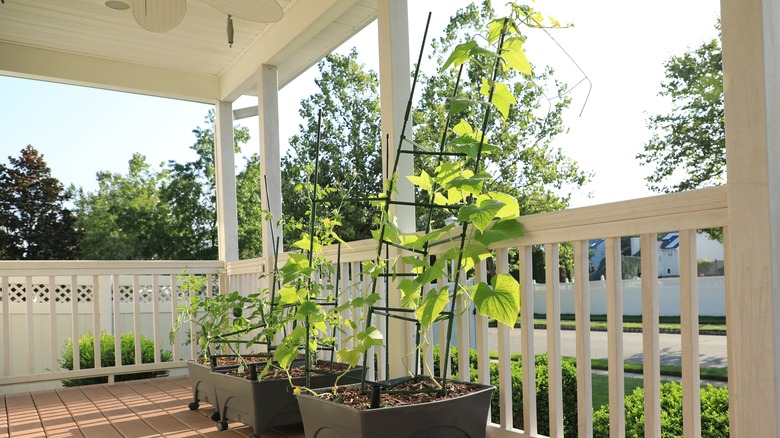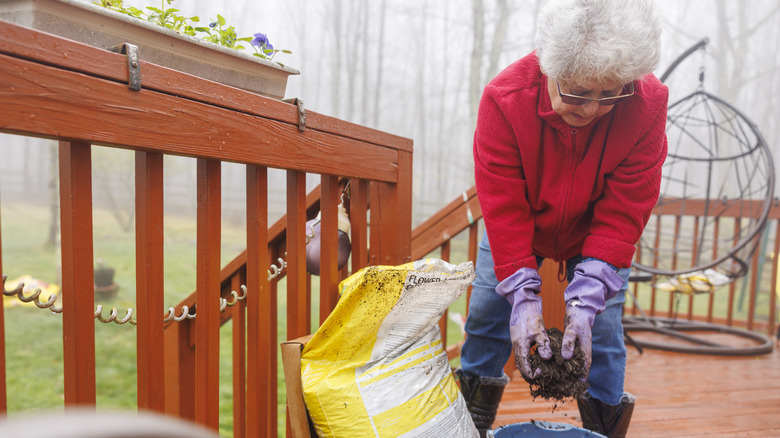The Secret Ingredient To Growing Large Cucumbers In A Container Or Grow Bag
We may receive a commission on purchases made from links.
Grow bags are undeniably convenient. They provide gardeners — space-challenged urban farmers and renters, in particular — the chance to create a quick and easy no-dig vegetable garden. It turns out, however, that what you put in them really matters. No, we're not talking about the plant you grow; what we mean here is the dirt the plant puts its roots down into. TikToker @perkyplantparent claims to have found that secret sauce — or, more aptly, the secret soil media — to nurturing grow bag cucumber vines guaranteed to reach the top of your trellis or fence line. Instead of filling your fabric planters with boring old soil you dig up from your garden beds, nestle your cucumber seedlings into a nutrient-rich bed of PittMoss potting mix.
The TikTok gardener in question ran an intriguing experiment. She planted Japanese cucumbers in grow bags filled with PittMoss; the others went into "just soil." The vines planted in PittMoss thrived while the dirt-planted vines appeared stunted. So, what in this supposed wonder product promotes such a boost in growth? According to PitMoss' official website, their standard potting mix is made from locally sourced recycled paper fiber that saves water and better collects and distributes nutrients to the plant's roots than standard soil. It's also "peat-free," meaning free of peat moss. This matters to eco-conscious gardeners as the ethics of sustainable peat moss harvesting is an area of debate.
Digging into soilless science
You may be asking at this point, how does all of this equal more abundant growth? The answer lies in the real differences between potting soil and garden soil, or, in this case, soilless media (also called potting or soilless mix) and dirt. Professor Dr. Nazim S. Gruda states in his 2021 book, Advances in Horticultural Soilless Culture, "Soilless culture systems are environmentally friendly, resource-efficient, and support sustainable intensification in agriculture."
Soilless mixes contain wetting agents designed to ensure the right balance of water retention and release. They create a light and airy environment inside a pot, making growing roots easy for an energy-challenged seedling. On the other hand, garden dirt or other soil-based mediums, like pure compost, pack tightly into a container (or grow bag) over time, holding onto too much water and cramping the plant's root system. They attract weeds and pests. What's more, if you use soilless mediums crafted from recycled or renewable materials, they're highly sustainable.
Source your super (non)soil
Whether you grow cucumbers on a trellis or leave them along the ground, you're likely very interested in emulating this TikToker's success. The easiest way is to head to the official PittMoss website. There, you can buy 10-quart bags of their Plentiful Organic Potting Mix for $17.99 each or, for an extra boost for your plants, 1 cubic foot of Performance Nutrient Enhanced Potting Soil for $26.99. Of course, there are alternatives — both peat-based and not. For example, Walmart sells 16-quart bags of Premier Horticulture PRO-MIX for $21.60. The Fafard Professional Potting Mix contains peat and is available for $20 for 1 cubic foot at PlantShed.
You could also attempt to reverse-engineer the product. While it's arguably impossible to replicate PittMoss' proprietary recycled paper medium, you could use other readily available soilless media. Simply mix a bushel of inorganic material (say, perlite or vermiculite) with another of porous organic matter (peat moss, coconut coir, or shredded bark). Add 1.75 cups of lime, 0.5 a cup of phosphate, a cup of fertilizer, and a little compost to this base. Another option is to mix a 2:1:1 ratio of porous organic matter, inorganic material, and sand. Add more fresh soilless medium to your existing mix once a year, season, or whenever you typically pot or repot your plants. Now, all that's left to do is channel @perkyplantparent and run some experiments of your own!

